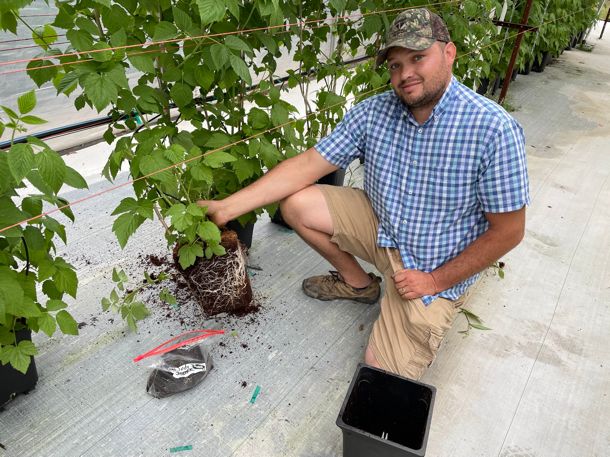By Lisa Rayburn, NCSU; Josh Mays, TriEst Ag Group, Inc.; James Hewitt, Lewis Nursery and Farms; and Gina Fernandez, NCSU
In 2021, NC State University started an on-farm research project with Lewis Nursery and Farms to investigate the feasibility of long-cane raspberry production in the state. Until now, commercial production of this high value crop has been limited to the western part of the state where the temperatures are cooler. In the coastal plain, heat and humidity take their toll on fruit quality and plantings are short-lived with low yields. But raspberry long canes present a possible alternative.
In a long-cane system, raspberry primocanes are grown in containers in a nursery before being shipped to the farm for fruiting. The nursery is traditionally in a cooler climate that is better suited for strong primocane growth. The plants are grown in soilless substrate and trained to produce 1 or 2 tall primocanes which are topped out at 160 cm (about 5 feet). These are the “long canes” that the system is named after.


Close attention has to be paid to venting the high tunnels to make sure they are warm in the winter and cool in the spring and summer. In addition, close attention is needed to manage moisture and nutrient levels in the substrate.

In our trials, the canes take approximately 90 days to reach the beginning of harvest although this can vary based on variety and pullout date. Early pullouts will take longer while later pullouts benefit from warmer temperatures and mature faster. Timing of pullout is chosen to coincide with the optimum harvest window for the market and to get the berries out of the tunnel before high temperatures result in fruit quality and retention issues. In southeastern NC, mid-January to mid-February looks to be the optimum pullout window for spring resulting in harvest from mid-April through early June.


The system is not without its challenges. Higher yields are needed as this system require a large upfront investment. The costs of grading and land preparation, high tunnels, irrigation system, pots, fertilizer, substrate and plants add up quickly.
Careful attention needs to be paid to fertility and water management during the growing season. The small size of the containers and limited buffering capacity can result in pH and nutrient problems developing and resulting in lost yield much more quickly than in a soil system. The grower needs to monitor the irrigation system on a daily basis including the pH and EC of the fertilizer solution entering and exiting the containers and the total amount of drainage.
Finally, fluctuating spring weather also poses a risk. Unseasonably warm weather can result in poor berry quality and dropped fruit. Likewise, strong storms and heavy winds pose a risk to high tunnel structures.
Coco coir is the industry standard substrate for long-cane raspberry production in Europe and Canada but our on-farm research is currently being conducted in southeastern NC to determine if a locally produced pine bark substrate can be used instead. This research is ongoing but early trends are promising. Pine bark substrate would not only provide a sustainable, local alternative to coco coir, but at a substantially cheaper price point.


Research is ongoing but raspberry long canes production may provide growers in the southeast with a sweet, new berry to offer their local customers.
This research has been made possible through the support of Lewis Nursery and Farms, TriEst Ag Group, Inc., the North American Raspberry & Blackberry Association, North Carolina Commercial Blackberry and Raspberry Association and North Carolina State University.